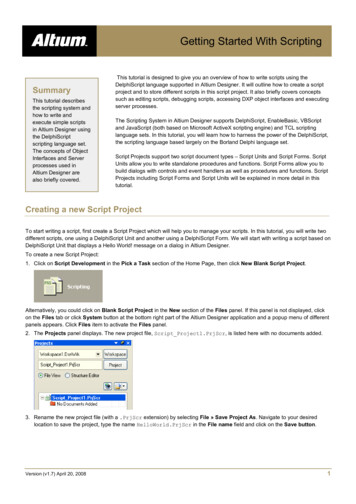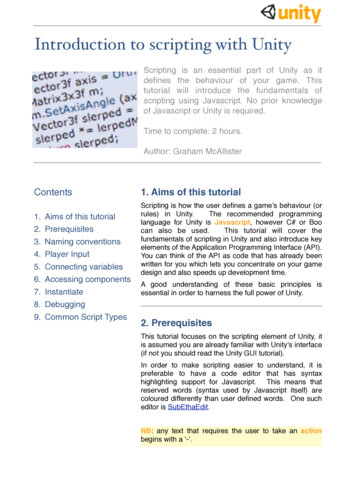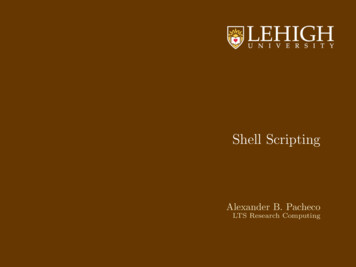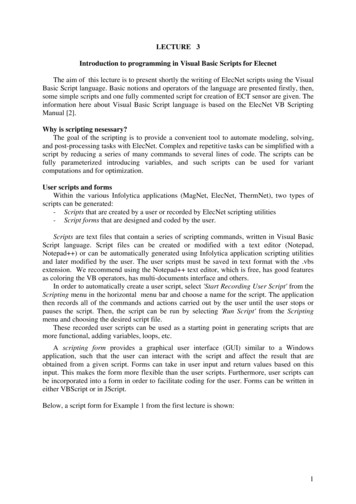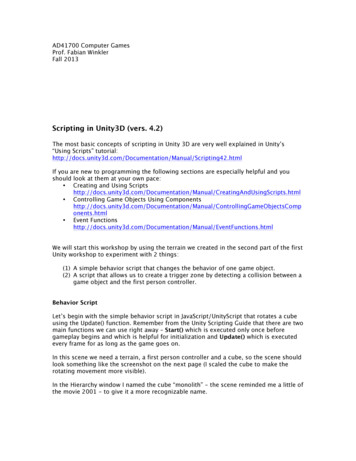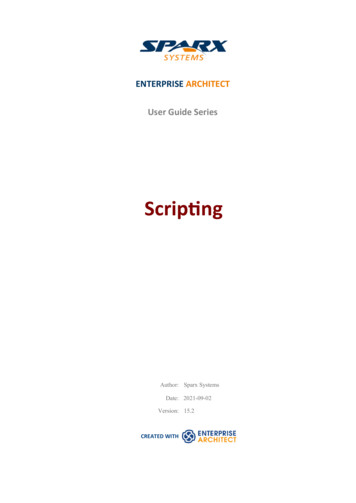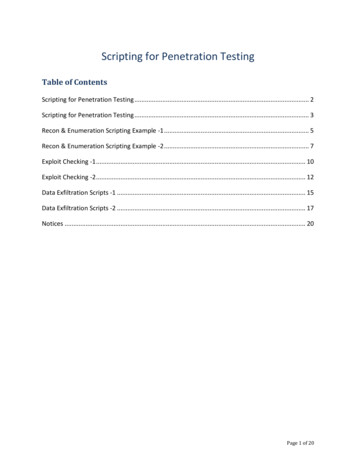
Transcription
UNIT-1INTRODUCTION TO SCRIPTING LANGUAGES1.1 Scripts and programs:Scripting is the action of writing scripts using a scripting language, distinguishing neatlybetween programs, which are written in conventional programming language such asC,C ,java, and scripts, which are written using a different kind of language.We could reasonably argue that the use of scripting languages is just another kind ofprogramming. Scripting languages are used for is qualitatively different from conventionalprogramming languages like C and Ada address the problem of developing large applicationsfrom the ground up, employing a team of professional programmers, starting from well-definedspecifications, and meeting specified performance constraints.Scripting languages, on other hand, address different problems: Building applications from ‘off the shelf’ components Controlling applications that have a programmable interface Writing programs where speed of development is more important thanrun-time efficiency.The most important difference is that scripting languages incorporate features thatenhance the productivity of the user in one way or another, making them accessible to peoplewho would not normally describe themselves as programmers, their primary employmentbeing in some other capacity. Scripting languages make programmers of us all, to some extent.1.2 Origin of scripting:The use of the word ‘script’ in a computing context dates back to the early 1970s,whenthe originators of the UNIX operating system create the term ‘shell script’ for sequence of
commands that were to be read from a file and follow in sequence as if they had been typed inat the keyword. e.g. an ‘AWKscript’, a ‘perl script’ etc. the name ‘script ‘ being used for a textfile that was intended to be executed directly rather than being compiled to a different form offile prior to execution.Other early occurrences of the term ‘script’ can be found. For example, in a DOS-basedsystem, use of a dial-up connection to a remote system required a communication package thatused proprietary language to write scripts to automate the sequence of operations required toestablish a connection to a remote system.Note that if we regard a scripts as a sequence of commands to control an application ora device, a configuration file such as a UNIX ‘make file’ could be regard as a script.However, scripts only become interesting when they have the added value that comesfrom using programming concepts such as loops and branches.1.3 Scripting today:SCRIPTING IS USED WITH 3 DIFFRENT MEANINGS:1. A new style of programming which allows applications to be developed much faster thantraditional methods allow,and maks it possible for applications to evolve rapidly to meetchanging user requirements.This style of programming frequently uses a scripting language tointerconnect ‘off the shelf ‘ components that are themselves written in conventionallanguage.Applications built in this way are called ‘glue applications’ ,and the language is calleda ‘glue language’.A glue language is a programming language (usually an interpreted scripting language) that isdesigned or suited for writing glue code – code to connect software components. They areespecially useful for writing and maintaining:Custom commands for a command shellSmaller programs than those that are better implemented in a compiled language
"Wrapper" programs for executables, like a batch file that moves or manipulates files anddoes other things with the operating system before or after running an application like aword processor, spreadsheet, data base, assembler, compiler, etc.Scripts that may changeRapid prototypes of a solution eventually implemented in another, usually compiled,language.Glue language PUnix ShellEmbeddable Common LispPurescripts (ksh, csh,bash, sh andeclPythonothers)ErlangRebolVBScriptJCLRexxWork Flow LanguageJScript and JavaScriptRubyWindows PowerShellXSLTLua2.Using a scripting language to ‘manipulate,customize and automate the facilities of anexisting system’,as the ECMAScript definition puts it.Here the script is used to control anapplicationthat prividesa programmable interface:this may be an API,though morecommonly the application is construted from a collection of objects whose properties andmethods are exposed to the scripting language.Example: use of Visual Basic for applications tocontrol the applications in the Microsoft Office Suite.3.Using a scripting language with its rich funcationaliy and ease of use as an alternate to aconventional language for general programming tasks ,particularly system programming andadministration.Examples: are UNIX system adminstrators have for a long time used scriptinglanguages for system maintenace tasks,and administrators of WINDOWS NT systems areadopting a scripting language ,PERL for their work.
1.4 Characteristics of scripting languages:These are some properties of scripting languages which differentiate SL from programminglanguages.Integrated compile and run:SL’s are usually characterized as interpreted languages,butthis is just an oversimplification.They operate on an immediate execution,without needto issue separate commond to compile the program and then to run the resulting objectfile,and without the need to link extensive libraries into he object code.This is doneautomatically.A few SL’S are indeed implemented as strict interpreters.Low overheads and ease of use:1.variables can be declared by use2.the number of different data types is usually limited3.everything is string by context it will be converted as number(vice versa)4.number of data strucures is limited(arrays)Enhanced functionality:SL’s usually have enhanced functionality in some areas.Forexample ,most languages provide string manipulation based on the use of regularexpressions,while other languages provide easy access to low-level operating systemfacilities,or to the API,or object exported by an application.Efficiency is not an issue:ease of use is achieved at the expense of effeciency,becauseefficiency is not an issue in the applications for which SL’S are designed.A scripting language is usually interpreted from source code or bytecode. By contrast,the software environment the scripts are written for is typically written in a compiledlanguage and distributed in machine code form.Scripting languages may be designed for use by end users of a program – end-userdevelopment – or may be only for internal use by developers, so they can write portionsof the program in the scripting language.
Scripting languages typically use abstraction, a form of information hiding, to spareusers the details of internal variable types, data storage, and memory management.Scripts are often created or modified by the person executing them, but they are alsooften distributed, such as when large portions of games are written in a scriptinglanguage.The characteristics of ease of use,particularly the lack of an explicit compile-link-loadsequence,are sometimes taken as the sole definition of a scripting language.1.5 Users For Scripting Lanuages:Users are classified into two types1. Modern applications2. Traditional usersModern applications of scripting languages are:1.Visual scripting: A collection of visual objects is used to construct a graphical interface.Thisprocess of constructing a graphical interface is known as visual scripting.the properties of visualobjects include text on button,background and foreground colors.These properties of objects canbe changed by writing program in a suitable language.The outstanding visual scripting system is visual basic.It is used to develop newapplications.Visual scripting is also used to create enhanced web pages.2.Scripting components:In scripting languages we use the idea to control the scriptable objectsbelonging to scripting architecture.Microsoft's visual basic and excel are the first applicationsthat used the concept of scriptable objects.To support all the applications of microsoft theconcept of scriptable objects was developed.3.Web scripting:web scripting is classified into threeforms.they are processing forms,dynamic web pages,dynamically generating HTML.Applications of traditional scripting languages are:1. system administration,2. experimental programming,3. controlling applications.Application areas :Four main usage areas for scripting languages:1. Command scripting languages2.Application scripting languages3.Markup language4. Universal scripting languages
1.Command scripting languages are the oldest class of scripting languages. They appeared in1960, when a need for programs and tasks control arised. The most known language from thefirst generation of such languages is JCL (Job Control Language), created for IBM OS/360operating system. Modern examples of such languages include shell language, described above,and also text-processing languages, such as sed and awk. These languages were one of the first todirectly include support for regular expression matching - a feature that later was included intomore general-purpose languages, such as Perl.2.Application scripting languages :Application scripting languages were developed in 1980s, inthe era of personal computers, when such important applications as spreadsheets and databaseclients were introduced, and interactive session in front of the PC became the norm. One of theprime examples of these languages is Microsoft-created Visual Basic language, and especiallyit’s subset named Visual Basic for Applications, designed explicitly for office applicationsprogramming3.Markup languages are a special case in the sense that they are not a real programminglanguages, but rather a set of special command words called ’tags’ used to mark up parts of textdocuments, that are later used by special programs called processors, to do all kinds oftransformations to the text, such as displaying it in a browser, or converting it to some other dataformat. The basic idea of markup languages is the separation of contents and structure, and alsoincluding formatting commands and interactive objects into the documents. The first markuplanguage named GML (Generic Markup Language) was created in 1969 by IBM. In 1986, ISOcreated a standard called SGML, based on GML ideas.4.Universal scripting languages :The languages that belong to this class are perhaps the mostwell-known. The very term ”scripting languages” is associated with them. Most of theselanguages were originally created for the Unix environment. The goals however were different.The Perl programming language was made for report generation, which is even reflected in itsname (Practical Extraction and Report Language). It is commonly said that the primary reasonfor it’s enormous popularity is the ability to write simple and efficient CGI scripts for formingdynamic web pages with this language. Perl was there in the right place at the right time. ThePython language was originally made as a tool for accessing system services of the experimentaloperating system Amoeba. Later it became a universal object-oriented scripting language.Implementations exist for the Java Virtual Machine and also for Microsoft IntermediateLanguage used on Microsoft .NET platform.Unlike Perl and Python, which make it easy to write completely standalone programs, Tcl reliesheavily on C and C extension modules.1.6 web scripting:Web is the most fertile areas for the application of scripting languages. Web scripting dividesinto three areasa. processing forms
b. creating pages with enhanced visual effects and user interaction andc. generating pages ’on the fly’ from material held in database.Processing Web forms:In the original implementation of the web , when the form is submitted for processing, theinformation entered by the user is encoded and sent to the server for processing by a CGI scriptthat generates an HTML page to be sent back to the Web browser.This processing requires string manipulation to construct the HTML page that constitutes thereplay, and may also require system access , to run other processes and to establish networkconnections. Perl is also a language that uses CGI scripting.Alternatively for processing the form with script running on the server it possible to do someclient –side processing within the browser to validate form data before sending it to theserver by using JavaScript, VBScript etc.Dynamic Web pages:‘Dynamic HTML’ makes every component of a Web page (headings, anchors, tables etc.) ascriptable object. This makes it possible to provide simple interaction with the user using scriptswritten in JavaScript/Jscript or VBScript, which are interpreted by the browser.Microsoft’s ActiveX technology allows the creation of pages with more elaborate userinteraction by using embedded visual objects called ActiveX controls. These controls arescriptable objects, and can in fact be scripted in a variety languages. This can be scripted byusing Perl scripting engine.Dynamically generated HTML:Another form of dynamic Web page is one in which some or all of the HTML is generated byscripts executed on the server. A common application of the technique is to construct pages
whose content is retrieved from a database. For example, Microsoft’s IIS web serverimplements Active Server Pages (ASP), which incorporate scripts in Jscript or VBScript.1.7 The universe of scripting languages:Scripting can be traditional or modern scripting, and Web scripting forms an important part ofmodern scripting. Scripting universe contains multiple overlapping worlds:the original UNIX world of traditional scripting using Perl and Tclthe Microsoft world of Visual Basic and Active controlsthe world of VBA for scripting compound documentsthe world of client-side and server-side Web scripting.The overlap is complex, for example web scripting can be done in VBScript,JavaScript/Jscript, Perl or Tcl. This universe has been enlarged as Perl and Tcl are used toimplement complex applications for large organizations e.g Tcl has been used todevelop a major banking system, and Perl has been used to implement an enterprisewide document management system for a leading aerospace company.1.8 Names and Values in Perl:1.8.1 Names:Like any other programming language,Perl manipulates variables which have a name(or identifier) and a value: a value is assigned to a variable by an assignment statement of theformname value;Variable names resemble nouns in English, and like English, Perl distinguishesbetween singular and plural nouns.A singular name is associated with a variable that holds asingle item of data (a scalar value), a plural name is associated with a variable that holds acollection of data items (an array or hash). A notable characteristic of Perl is that variable
names start with a special character that denotes the kind of thing that the name stands for scalar data ( ), array (@), hash (%), subroutine (&) etc. The syntax also allows a name thatconsists of a single non-alphanumeric character after the initial special character, eg. , ?;such names are usually reserved for the Perl system.If we write an assignment, eg. j j 1, the occurance of j on the left denotes a storagelocation, whilw the right-hand occurance denotes the contents of the storage location. Wesometimes refer to these as the lvalue and rvalue of the variable: more precisely we aredetermining the meaning of the identifier in a left-context or a right-context. In the assignmenta[j] a[j] 1, both occurances of j are determined in a right-context, even though one of themappears on the left of the assignment.In conventional programming languages, new variables are introduced by adeclaration, which specifies the name of the new variable and also its type, which determinesthe kind of value that can be stored in the variable and, by implication, the operations that canbe carried out on that variable.Scalar data:Strings and numbers:In common with many scripting languages, Perl recognizes just two kinds of scalardata: strings and numbers. There is no distinction between interger and real numbers asdifferent types.Perl is a dynamically typed language: the system keeps track of whether avariable contains a numeric value or a string value, and the user doesn't have to worry aboutthedifference between strings and numbers since conversions between the two kinds of dataare done automatically as required by the context in which they are used.Boolean values:All programming languages need some way of representing truth values and Perl is noexception. Since scalar values are either numbers or strings, some covention is needed for
representing Boolean values, and Perl adopts the simple rule that numeric zero, "0" and theempty string (" ") mean false, and anything else means true.Numeric constants:Numeric constants can be written in a variety of ways, including specific notation, octaland hexadecimal. Although Perl tries to emulate natural human communication, the commonpractice of using commas or spaces to break up a large integer constant into meaningful digitgroups cannot be used, since the comma has a syntactic significance in Perl. Instead,underscores can be included in a number literal to improve legibility.String constants:String constants can be enclosed in single or double quotes. The string is terminated bythe first next occurance of the quote which started it, so a single-quoted string can includedouble quotes and vice versa. The q (quote) and qq (double quote) operators allow you to useany character as a quoting character. Thusq / any string/ or q ( any string )are the same as'any string' and qq / any string / or qq ( any string )are the same as"any string"1.8.2 Variables and assignment:Assignment:Borrowing from C, Perl uses ' ' as the assignment operator. It is important to notethat an assignment statement returns a value, the value assigned. This permits statements like
b 4 ( a 3) ;which assigns the value 3 to a and the value 7 to b.If it is required to interpolate a variablevalue without an intervening space the following syntax, borrowed from UNIX shell scripts , isused: a "Java ; b " { a } Script" ;which gives b the value "JavaScript". STDIN - a special value:When the 'variable' STDIN appears in a context where a scalar value isrequired, it evaluates to a string containing the next line from standard input, including theterminating newline. If there is no input queued, Perl will wait until a line is typed and thereturn key pressed. The empty string is treated as false in a Boolean context. If STDIN appears on the right-hand side of an assignment to a scalar variable, the string containing theinput line is assigned to the variable named on the ;eft. If it appears in any other scalar contextthe string is assigned to the anonymous variable: this can be accessed by the name - : manyoperations use it as a default.1.8.3 Scalar Expressions:Scalar data items are combined into expressions using operators.operators, which are ranked in 22 precedence levels.Perl has a lot ofThese are carefully chosen so that the‘obvious’ meaning is what You get , but the old advice still applies: if in doubt ,use brackets toforce the order of evaluation . In the following sections we describe the available operators intheir natural groupings-arithmetic , strings,logical etc .Arithmetic operators:Following the principles of ‘no surprises’ Perl provides the usual
Arithmetic operators, including auto-increment and auto-decrement operators after themanner of C: note that in c 17 ; d c;The sequence is increment and the assign, whereas in c 17 ; d c ;The sequence is assign then increment . As C, binary arithmetic operations can be combinedwith assignment, e.g. a 3;This adds 3 to a, being equivalent to a a 3;As in most other languages, unary minus is used to negate a numeric value; an almost neverused unary plus operator is provided for completeness.String OperatorsPerl provides very basic operators on strings: most string processing is one using built-infunctions expressions, as described later.Unlike many languages use as a concatenation operator for strings, Perl uses a period forthis purpose: this lack of overloading means that an operator uniquely determines the contextfor its operands. The other string operator is x, which is used to replicate strings, e.g. a ”Hello” x 3;Sets a to “HelloHelloHello”.The capability of combining an operator with assignment is extended to string operations. E.g. foo . “ “ ;
Appends a space to foo.So far, things have been boringly conventional for the most part. However, we begin to get ataste of the real flavor of perl when we see how it adds a little magic when some operators,normally used in arithmetic context, are used in a string context.Two examples illustrate this.1.Auto increment :If a variable has only ever been used in a string context, the auto increment operator can beapplied to it. If the value consists of a sequence of letters, or a sequence of letters followed bya sequence of digits, the auto increment takes place in string mode starting with the rightmost character, with ‘carry’ along the string. For example, the sequence a ‘a0’ ; b ‘Az9’ ;Print a, ‘ ‘, b; “/n”;Prints a1 Ba0.2.Unaryminus :This has an unusual effect on non numeric values. Unary minus applied to a string whichstarts with a plus or minus character returns the same string, but starting with the oppositesign. Unary minus applie to an identifier returns a string consists of minus prefixed to thecharacters of the identifiers. Thus if we have a variable named config with the value “ foo”,then –config evaluates the string “-foo”. This is useful, for example, in constructing commandarguments are introduced by –Comparison operators:The value of comparisons is returned as 1 if true, and an empty string (“ ”) if false, inaccordance with the convention described earlier.
Two families of comparison operators provide, one for numbers and one for strings. Theoperator used determines the context , and perl converts the operands as required to matchthe operator.This duality is necessary because a comparison between strings made up entirely numericaldigits should apply the usual rules for sorting strings ASCII as a collating sequence, and this maynot give the same result as the numerical comparison(‘5’ ’10’) returns the value true as anumerical comparison having been converted into (5 10) where as the string comparison (‘5’ lt‘10’) returns false, since 10 comes before 5 in the canonical sort order for ASCII strings.The comparison operator ( for numbers, cmp for strings), performs a three way test,returning -1 for less-than, 0 for equal an 1 for greater-than.Note that the comparison operators are non associative, so an expression like a b cIs erroneous.logical operators:The logical operators allows to combine conditions using the usual logical operations‘not’(!, not), ‘and’(&&,and) and ‘or’( ,or). Perl implements the ‘and’ and ‘or’ operators in‘shortcut’mode, i.e evaluation stops as soon as the final result is certain using the rules false&&b false, and true b true.Before Perl 5,only the !, && and operators were provided.The new set, not, and,or, areprovided partly to increase readability, and partly because their extra-low precedence makes itpossible to omit brackets in most circumstances-the precedence ordering is choosen so thatnumerical expressions can be compared without having to enclose them in brackets, e.g.Print”OK\n” if a 10 and b 12;
Bitwise operators:The unary tilde( ) applied to a numerical argument performs bitwise negation on its operand,generating the one’s compliment. If applied to a string operand it complements all the bits inthe string – effective way of inverting a lot of bits. The remaining bitwise operators - & (and), (or) and (exclusive or)- have a rather complicated definition. If either operand is a number or avariable that has previously been used as a number, both operands are converted to integers ifneed be, and the bitwise operation takes place between the integers. If the both operands arestrings, and if variables have never been used as numbers, Perl performs the bitwise operationbetween corresponding bits in the two strings, padding the shorter strings with zeros asrequired.Conditional expressions:A conditional expression is one whose values is choosen from two alternatives at run-timedepending on the outcome of a test. The syntax is borrowed from C:Test ? true exp: false expThe first expression is evaluated as Boolean value : if it returns true the whole expression isreplaced by true exp,otherwise it is replaced by false exp, e.g. a ( a 0)? 0 : a;1.8.4 Control structures:The Control Structures for conditional execution andrepetition all the controlmechanisms is similar to C.1. BLOCKS:A block is a sequence i\of one or more statements enclosed in curly braces.Eg: { positive 1;
negative -1;}The last statement is the block terminated by the closing brace.In, Perl they use conditions to control the evaluation of one or more blocks. Blocks canappear almost anywhere that a statement can appear such a block called bare block.2. CONDITIONS:A condition is a Perl expression which is evaluated in a Boolean context: if itevaluates to zero or the empty string the condition is false, otherwise it is true.Conditions usually make use of relational operators.Eg: total 50 total 50 and total 100Simple Conditions can be combined into a complex condition using the logicaloperators. A condition can be negated using the ! operator.Eg: !( total 50 and total 100)3. CONDITIONAL EXECUTION:If-then-else statementsif ( total 0){print “ total\n”if ( total 0){print “ total\n”} else {
print “bad total!\n”-A single statement is a block and requires braces round it. The if statement requiresthat the expression forming the condition is enclosed in brackets. The construct extendsto multiple selectionsEg: if ( total 70) { grade ”A”;} elsif ( total 50) { grade ”B”;} elsif ( total 40) { grade ”C”;} else { grade ”F”; total 0;}Alternatives to if-then-elseTo use a conditional expression in place of an if-then-else construct.if ( a 0)( b 0)else ( b 1)can be written as b ( a 0)? 0:1;To use the ‘or’ operator between statementsEg: open (IN, ARGV[0] or die“Can’t open ARGV*0 \n”;
Statement qualifiersA single statement(not a block) can be followed by a conditional modifier.Eg: print “OK\n”print “Weak\n”ifif volts 1.5; volts 1.2 and volts 1.5;print “Replace\n”if volts 1.2;Code using Conditional expressions,Eg: print (( volts 1.5)? “Ok\n”;(( volts 1.2)? “Weak\n”;“Replace\n”));4. REPETITION:Repetition mechanisms include both Testing Loops Counting LoopsTESTING LOOPS
While ( a! b)if ( a b) { a a- b} else { b b- a}}With the if statement, the expression that forms the condition must be enclosed inbrackets. But now, while can be replaced by until to give the same effect. Singlestatement can use while and until as statement modifiers to improve readability.Eg: a 2 while a b; a 2 until a b;Here, although the condition is written after the statement, it is evaluated before thestatement is executed, if the condition is initially false the statement will be neverexecuted.When the condition is attached to a do loop is same as a statement modifier, so theblock is executed at least once.do { .} while a! b;Counting Loops:In C,
for ( i 1; i 10; i ) { i square i* i; i cube i**3;print “ i\t i square\t i cube\n”;}In Perl,foreach i (1 10), i square i* i; i cube i**3;print “ i\t i square\t i cube\n”;}1.9 LIST,ARRAYS AND HASHES:1.9.1 LISTS:A list is a collection of scalar data items which can be treated as a whole, and has atemporary existence on the run-time stack.It is a collection of variables, constants (numbers or strings) or expressions, which is tobe treated as a whole.It is written as a comma-separated sequence of values, eg: “red” , “green” , “blue”.A list often appears in a script enclosed in round brackets. For eg:( “red” , “green”, “blue” )Shorthand notation is acceptable in lists, for eg:(1.8)(“A”.”H” , “O”.”Z”)qw(the quick brown fox) is a shorthand for (“the” , ”quick” , ”brown” , ”fox”).
Arrays and Hashes: These are the collections of scalar data items which have an assignedstorage space in memory, and can therefore be accessed using a variable name.Arrays:An array is an ordered collection of data whose comparisions are identified by an ordinalindex: It is usually the value of an array variable.The name of the variable always starts with an @, eg: @days of week.NOTE: An array stores a collection, and List is a collection, So it is natural to assign a listto an array.Eg: @rainfall (1.2 , 0.4 , 0.3 , 0.1 , 0 , 0 , 0 );A list can occur as an element of another list.Eg: @foo (1 , 2 , 3, “string”);@foobar (4 , 5 , @foo , 6);The foobar result would be (4 , 5 , 1 , 2 , 3 , “string” , 6);Hashes:An associative array is one in which each element has two components : a key and avalue, the element being ‘indexed’ by its key.Such arrays are usually stored in a hash table to facilitate efficient retrieval, and for thisreason Perl uses the term hash for an associative array.Names of hashes in Perl start with a % character: such a name establishes a list context.The index is a string enclosed in braces(curly brackets).Eg: somehash{aaa} 123; somehash,“ a”- 0;//The key is a the current value of a.%anotherhash %somehash;
Working With Arrays And Lists:Array Creation: Array variables are prefixed with the @sign and are populated using either paranthesisor the qw operator.Eg: @array (1 , 2 ,”Heelo”);@array qw/This is an array/; In C, C , Java; Array is a collection of homogeneous elements, whereas; In Perl, Array isa collection of heterogeneous elements.Accessing Array Elements: When accessing an individual element, we have to use the ‘ ’ symbol followed byvariable name along with the inde
forms.they are processing forms,dynamic web pages,dynamically generating HTML. Applications of traditional scripting languages are: 1. system administration, 2. experimental programming, 3. controlling applications. Application areas : Four main usage areas for scripting languages: 1. Command scripting languages 2.Application scripting languages
